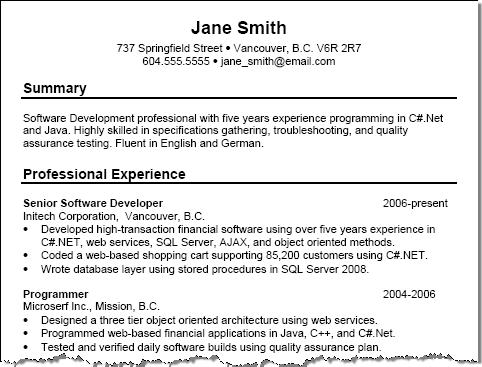
Putting together a resume is very serious business. Often it is the first impression you will make on a prospective employer. Hopefully, after looking over your resume, the employer will grant you the opportunity to make a second impression.
We can look at the resume as a print advertisement or a marketing brochure. If you take a look through a magazine you will see many ads. Try to find one that tells you to buy a product because the company needs to increase its profits. You will be hard pressed to find such a beast. The ads you see tell you what the manufacturer's product can do for you — make your smile bright, your hair shiny, or simply make your life better. When putting together your resume, evaluate the needs of the employer and then determine how you can fill those needs. If you have access to a computer and a quality printer, you can design a targeted resume for every job for which you apply. If you have to mass produce your resume, you will have to do a little guesswork to come up with one that will impress everyone.
Choosing a Resume Format
Next you must determine what type of resume format to use. There are three basic types: chronological, functional, and a combination of the two. The following sections will explain what each of these types are and when to choose one type over another.
Chronological Resume

The chronological resume is probably the one with which most people are familiar. On it, work experience is listed in reverse chronological order (most recent job first). The period of time during which you were employed is listed first, followed by the name of the employer and then the employer's location. A description for each job is also included. Following work history is a section on education. If you are trying to show career growth, a chronological resume may be the way to go. If your most recent job is store manager, while the one before that is department manager, and the one before that is sales clerk, you can show a history of promotion. However, if your work history has been spotty or if it has been stagnant you shouldn't use a chronological resume. If you are changing careers, a chronological resume is not for you either.
Functional Resume
A functionally formatted resume lists experience in skills clusters. A truly functional resume omits dates and may not even list specific jobs and employers. As you might imagine, hiring decision-makers especially loathe the purely functional resume for its omission of this key employer and date information. A compromise is known as the chrono-functional, hybrid, or combination format, which is a mostly functional format that also includes a bare-bones work history in reverse chronological order. Such a work-history section includes only job title, name and location of employer, and dates of employment. The job-seeker doesn’t list what he or she did in each job because that information already is listed in the functional section.
Employers do not like functional formats or even chrono-functional because they want to see dates and get a clear picture of how your career has progressed. “I ignore resumes that do not include dates,” said Miriam Torres, president of HRStaff Consulting, an executive-search firm in Miami Beach, FL. In fact, decision-makers will often read your resume from the bottom up to see how your career has developed.